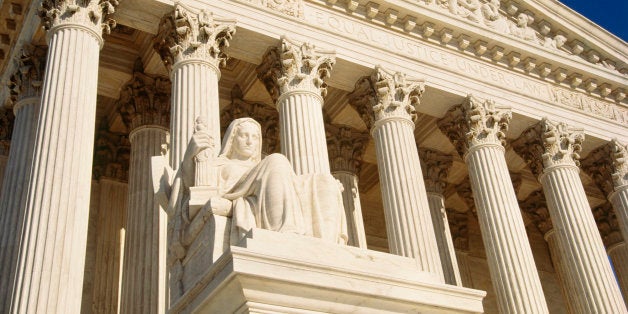
One of the best shows in the town of Washington, D.C. is not on television. It is an oral argument in before the United States Supreme Court. The nine justices are appointed by the President and confirmed after they assure the U.S. Senate they will be dispassionate "umpires."
Despite frequent entreaties by C-SPAN and others, they have refused to allow TV cameras in their august courtroom. Only the handful of spectators who line up for hours--and some lawyers and reporters--have the privilege of entering that truly majestic chamber and seeing them in action.
The court does make audio recordings of the arguments, and uploads them to its web site at the end of each week. Many of the cases are mundane, brought by those impacted by a provision of law or legislation. On major cases, the justices have agreed to same-day audio release. You have to recognize the voices to appreciate the goings on, unless a lawyer presenting the case responds to a question by addressing, "Justice Kennedy..." or whomever. And if you listen regularly, you can begin to tell Justice Kagan from Justice Sotomayor from Justice Ginsburg (she speaks extremely softly). If someone interrupts with a bitingly funny line, it is apt to be Justice Antonin Scalia. No need to recognize Justice Clarence Thomas; he is seldom heard, except when he is called upon to summarize an opinion, and then the Chief Justice introduces him.
The press section is at the side of the courtroom, reporters who cover legal issues full-time seated up front, along with artists if a network sends them. Those of us who cover the court only occasionally sit behind a row of pillars and curtains, so we barely glimpse the justices and strain to listen and puzzle out who is speaking.
When the chief justice pounds his gavel after the allotted time and says, "the case is submitted," we reporters rush out and down the marble front steps, grabbing coats on the way if it's a cold winter day. The lawyers, and sometimes their clients, follow and head for a bank of microphones, taking their case to the court of public opinion, giving us our sound bites to flesh out the story. For television, producers have selected video to include. On decision days, it's a breathless race to a microphone to get headlines on the air, and can be a challenge to get the nuances right.
What makes the argument one of the best shows in town is that the justices are, on average, brilliant. While they pose sharp questions to the lawyers presenting each side of the case--and often begin to interrupt after a lawyer has barely spoken his/her first few words--their goal seems most of all to persuade each other.
A memorable example was the argument I covered on the constitutionality of Obamacare, and its requirement that adults either have coverage or pay a penalty, which the Court ultimately upheld by calling it a tax.
Justice Scalia assailed the law's requirement that young adults have health insurance: "These people are not stupid. They're going to buy insurance later. They're young and need the money now. When they think they have a substantial risk incurring high medical bills, they'll buy insurance like the rest of us."
Justice Elena Kagan scoffed that a youngster hurt in an accident would be able to phone and obtain insurance while awaiting the ambulance: "Young people and healthy people say, 'why should we participate; we can just get it later when we get sick.' So, they leave the market. The rates go up further. More people leave the market. And the whole system crashes and burns, becomes unsustainable."
Justice Kagan was making the same assertion the insurance companies made when they insisted on a mandate for coverage if they could no longer turn their backs on applicants with pre-existing conditions.
Similarly, in the same-sex marriage case, to fellow justices who sought to link marriage to the goal of raising children, Kagan suggested that "the best way to promote this procreation-centered view of marriage is just to limit marriage to people who want children." And Justice Ruth Bader Ginsburg chimed in, "Suppose a couple, a 70-year-old couple comes in and they want to get married."
These cases resulted in ground-breaking 5-4 decisions, that came about when one justice appointed by a Republican President sided with four named by Democrats. Justices Kagan and Sotomayor were appointed by President Obama, Justice Scalia by President Ronald Reagan. Justice Samuel Alito was appointed by President George W. Bush to replace Sandra Day O'Connor, who was also appointed by President Reagan. She had been a judge and Republican leader in the Arizona State Senate.
O'Connor made it clear she, unlike her successor, would have voted against allowing corporations the unlimited right to contribute to political campaigns, and also viewed issues related to affirmative action and women's rights differently. Since leaving the court, she has campaigned against the election of judges because the public sees them beholden to contributors, and campaigned for the restoration of "civics" education in the schools, so students learn how their government works before they are old enough to be inundated with political half-truths.
Each newly-elected President can with a stroke of a pen overturn the executive orders of his predecessor. But the appointment of Justices of the Supreme Court leaves a long-term legacy. And Senators increasingly vote on confirmation from their political perspective on the social and economic issues that make their way through the courts. It's something that ought to be important for voters to consider.